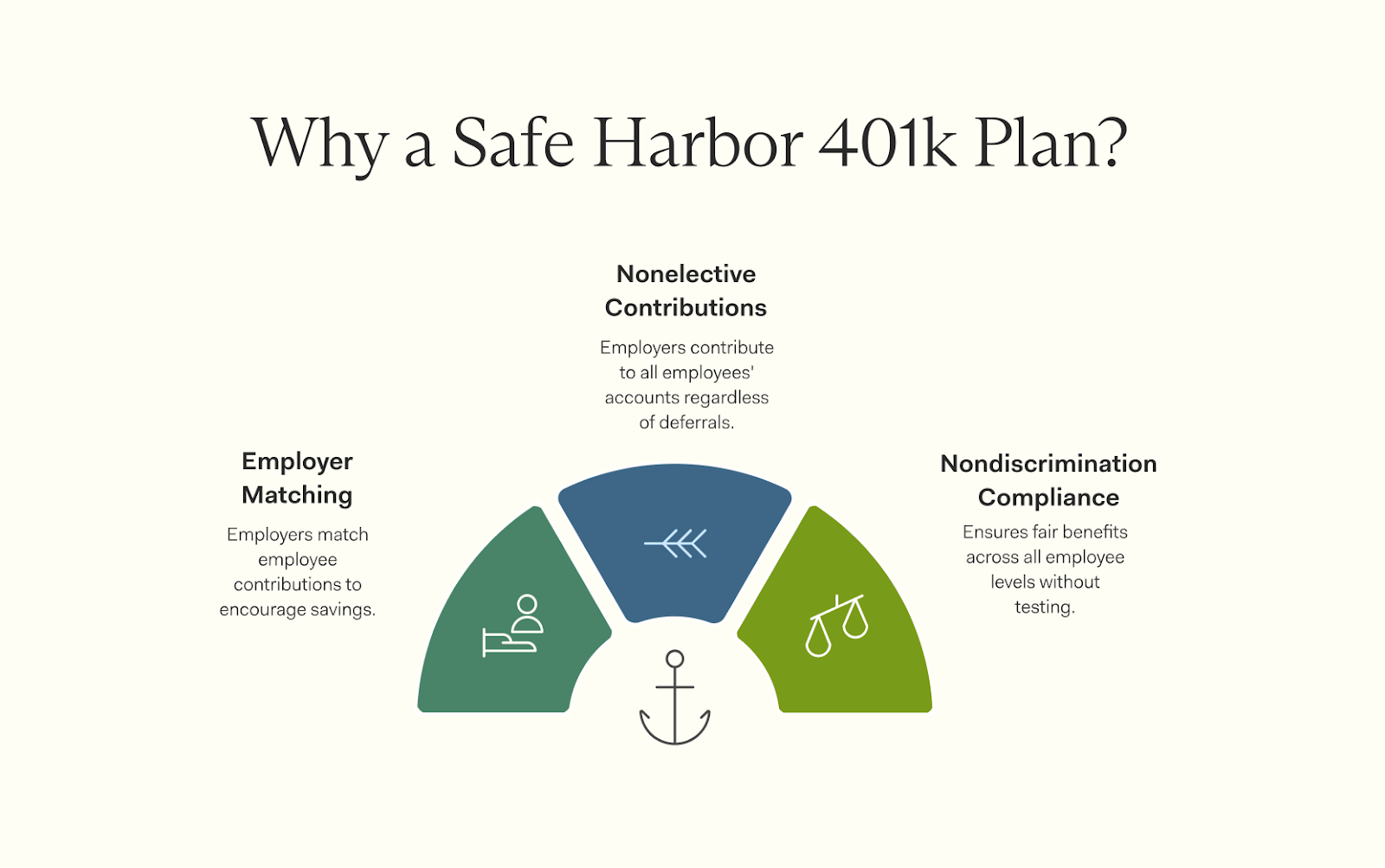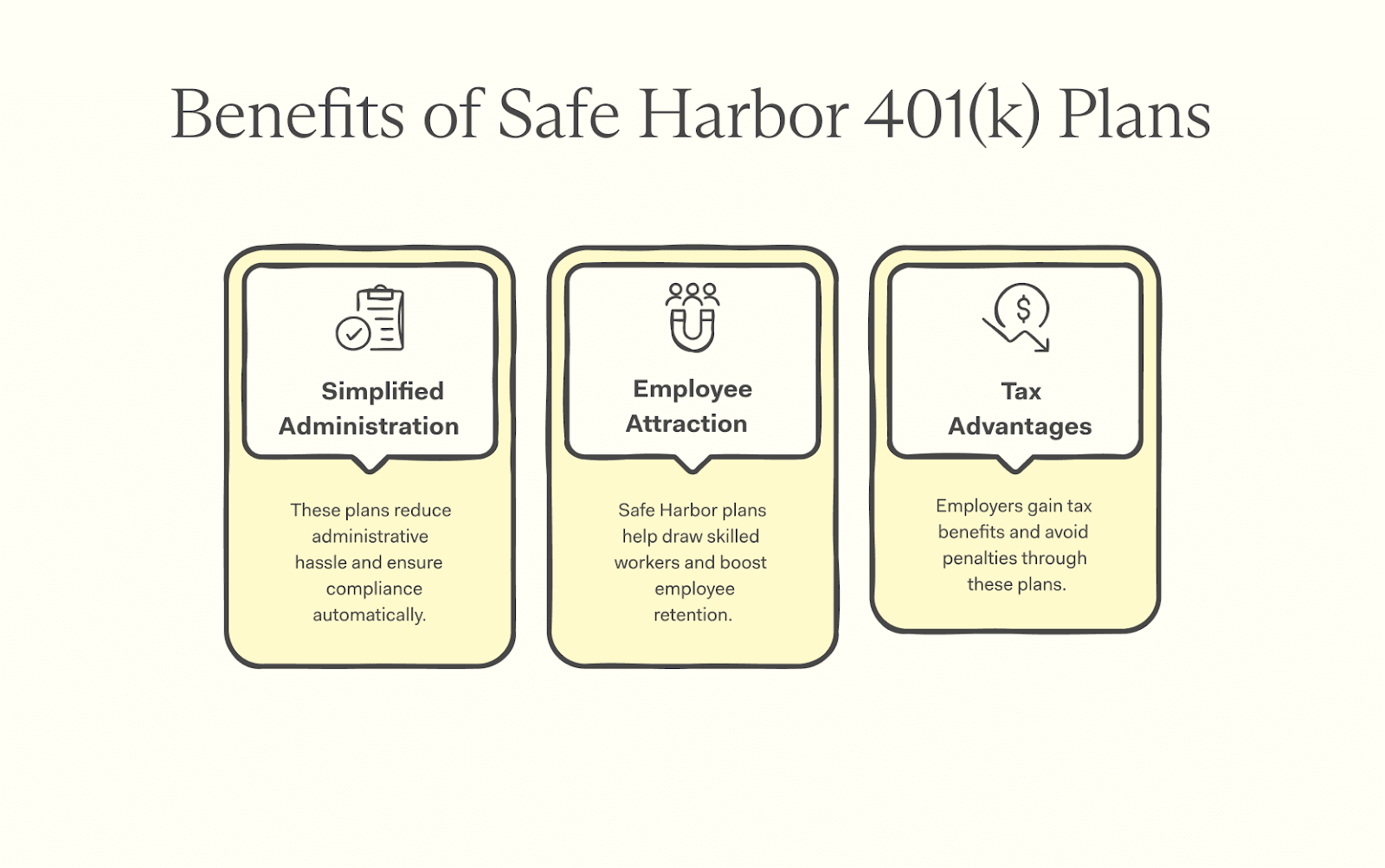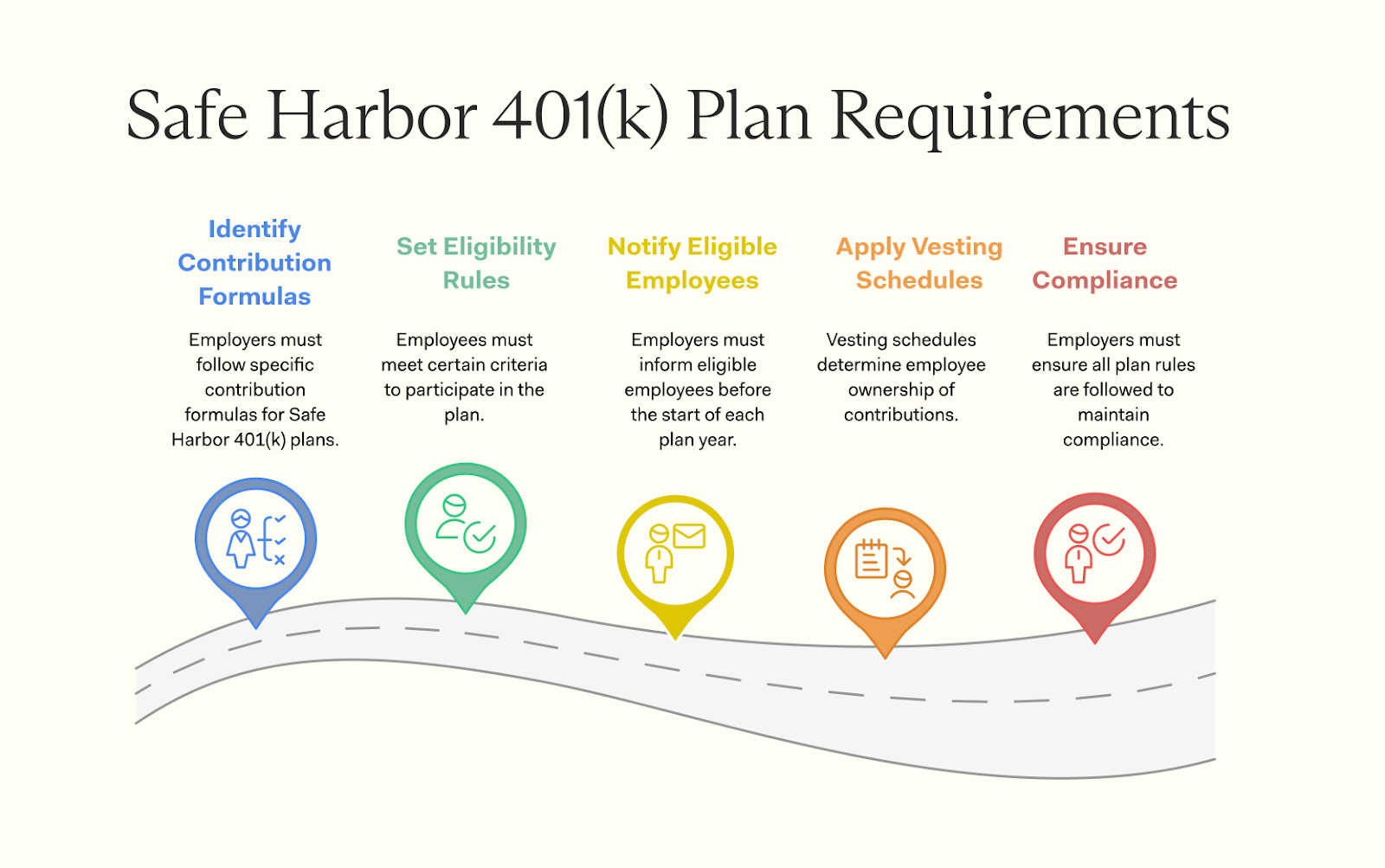Discover the benefits of Safe Harbor 401(k) plans for employers, including compliance details and how they can enhance employee satisfaction.
Saving for retirement can feel challenging, especially for small businesses and their employees. Business owners often face hurdles like complicated rules, compliance testing, and ensuring all employees are treated fairly in a retirement plan.
A Safe Harbor 401(k) plan can fix these problems. It offers an easier way to avoid annual nondiscrimination testing while helping employers make contributions that benefit everyone.
This blog will explain what a Safe Harbor 401(k) is, how it works, its benefits, and what's required to set one up.
This retirement savings option requires employers to make mandatory contributions, which can be either matching contributions or nonelective contributions.
These employer contributions must fully vest immediately, giving employees full ownership of the funds right away.
This type of plan helps businesses avoid complex IRS nondiscrimination tests. It ensures that both highly compensated and non-highly compensated employees benefit equally from the plan's features.
Employers use these plans to streamline compliance and encourage employee participation in saving for retirement.
Safe Harbor plans are a win-win—simplified compliance for companies, immediate benefits for workers.

Safe Harbor 401(k) plans offer unique perks for employers and employees alike. These features make complying with IRS rules much easier—while boosting employee savings.
Employers make matching contributions based on how much an employee contributes to their 401(k). A common option is the basic safe harbor match. Here, employers match 100% of the first 3% of an employee's compensation and 50% of the next 2%.
This total equals up to a maximum of 4%.
Another choice is the enhanced safe harbor match. Employers may contribute a higher percentage than required, such as matching dollar-for-dollar on all deferrals up to 6%. All employer matching contributions must be fully vested immediately.
Employees receive these funds regardless of whether they stay with the company long-term.
Nonelective contributions are safe harbor employer contributions given to all eligible employees, regardless of their own deferrals. These are equal to at least 3% of each employee's compensation.
Employees get these funds even if they don't contribute anything themselves.
This type of contribution helps employers meet safe harbor requirements and avoid discrimination testing issues. It also ensures rank-and-file employees benefit equally. Next, let's look at automatic compliance with nondiscrimination testing.
Safe Harbor 401(k) plans remove the hassle of nondiscrimination testing. These tests, like the actual contribution percentage (ACP) and actual deferral percentage (ADP), ensure key employees and non-highly compensated employees receive fair benefits.
Employers meet compliance by making safe harbor contributions—either match contributions or nonelective contributions. This structure benefits both rank-and-file employees and employers while avoiding penalties for excess contributions.
Safe Harbor 401(k) plans come in different types, each with unique rules and benefits—learn which one fits your company's needs.
These plans require employers to make either matching or nonelective contributions. Matching follows a basic formula, such as 100% on the first 3% of employee deferrals and 50% on the next 2%.
Nonelective contributions involve contributing at least 3% of compensation for all eligible employees, even if they don't defer.
These plans automatically meet nondiscrimination testing rules, benefiting both highly compensated and rank-and-file employees. Employers must provide an annual notice to inform employees about their benefits. Contributions are fully vested immediately.
QACAs require automatic enrollment for eligible participants, ensuring employees save for retirement through payroll deductions.
Employee contributions start at 3% of pay and increase annually by 1%, up to at least 6%, but not exceeding 10% in the first year. The plan allows employees to opt out or change their deferral percentage.
Employers must make either a nonelective contribution of 3% to all eligible employees or a matching contribution of 100% on the first 1% of deferred compensation plus 50% on the next 5%.
Contributions may be subject to a vesting schedule of up to two years. This type of safe harbor plan helps meet nondiscrimination testing requirements automatically.

Safe Harbor 401(k) plans offer simplicity, savings, and a chance to keep top talent—explore more to see how they could benefit your business.
These plans reduce administrative hassle. Employers don't need to worry about nondiscrimination testing if the plan meets Safe Harbor status.
The plan design ensures compliance automatically. Employer safe harbor contributions, like nonelective or matching, simplify maintaining fairness for all employees.
Safe Harbor 401(k) plans help draw skilled workers. The plan includes benefits like employer matching or nonelective contributions, making retirement savings more appealing. Workers often stay longer when they see these solid perks in their employee's account.
Plans that allow employees to participate easily add value for both businesses and staff. Offering secure retirement accounts shows you care about your team's future, boosting morale.
Employers can use this as a strong tool to keep rank and file employees while attracting new talent too!
Employers gain tax benefits through retirement contributions in a Safe Harbor 401(k) plan. Matching or nonelective contributions are tax-deductible, reducing the company's taxable income.
Plans also avoid penalties associated with failed nondiscrimination tests.
Offering these plans helps employers stay compliant while lowering their financial burden during tax season. Next, let's explore the requirements for Safe Harbor 401(k) Plans.

Safe Harbor 401(k) plans have specific rules employers must follow. These include certain contribution options, eligibility guidelines, and timelines to stay compliant.
Employers must follow set contribution formulas for Safe Harbor 401(k) plans. These include matching contributions or nonelective contributions. Matching requires the company to match employee deferrals up to a certain percentage, like 100% of the first 3% of pay and 50% for the next 2%.
Nonelective means contributing at least 3% of every eligible worker's compensation, even if they don't contribute.
The plan document must detail these formulas clearly. Employers cannot reduce contributions mid-year under most circumstances. This ensures fairness and compliance with IRS rules while benefiting both highly compensated employees and non-highly compensated ones.
Next is eligibility rules that define who can participate in the plan.
Employees must work at least 1,000 hours in a year to qualify for Safe Harbor 401(k) plans. Some plans let part-time employees who work 500 hours per year for three years participate too.
The plan can also set an age requirement of up to 21 years. Employers must notify eligible workers with a Safe Harbor notice before the start of each plan year. Next, learn about vesting schedules and how they affect contributions!
Eligibility rules decide who can participate; vesting schedules control ownership of contributions. Employer contributions, like matching or nonelective contributions, may require employees to stay for a set period before fully owning the funds.
Safe Harbor 401(k) plans often use immediate or short-vesting schedules. Immediate vesting means plan participants own employer-matched or nonelective safe harbor amounts right away.
This approach simplifies plan administration and ensures employee access to their accounts without delays.
A Safe Harbor 401(k) plan simplifies retirement savings for employers and employees. It removes complicated compliance tests while ensuring fair contributions. Employers can attract talent and lower tax burdens at the same time.
Employees benefit from guaranteed contributions to their accounts. These plans are easy to set up with clear rules and deadlines to follow. Does your company need a new way to boost retirement benefits? A Safe Harbor plan might be the answer! Start exploring options today—secure a stronger financial future for everyone involved.
A Safe Harbor 401(k) plan is a type of retirement savings plan that simplifies compliance with IRS rules by requiring employers to make minimum contributions for employees.
Non-elective contributions are made by the employer directly to each eligible employee's account, regardless of whether the employee makes elective deferrals.
Yes, the basic employee deferral limits apply. For 2025, these include elective deferrals up to $23,500, plus an additional $7,500 if you're aged 50 or older.
Yes, but specific deadlines must be followed when adding a safe harbor nonelective provision or making mid-year changes under the Secure Act guidelines.
If the plan is top-heavy—meaning key employees hold more than 60% of total assets—the employer must meet obligations under the plan by making required minimum contributions for non-highly compensated employees.
The plan allows all eligible employees to participate as long as they meet requirements set by the company's plan and comply with safe harbor deadlines and rules like QACA (Qualified Automatic Contribution Arrangement).